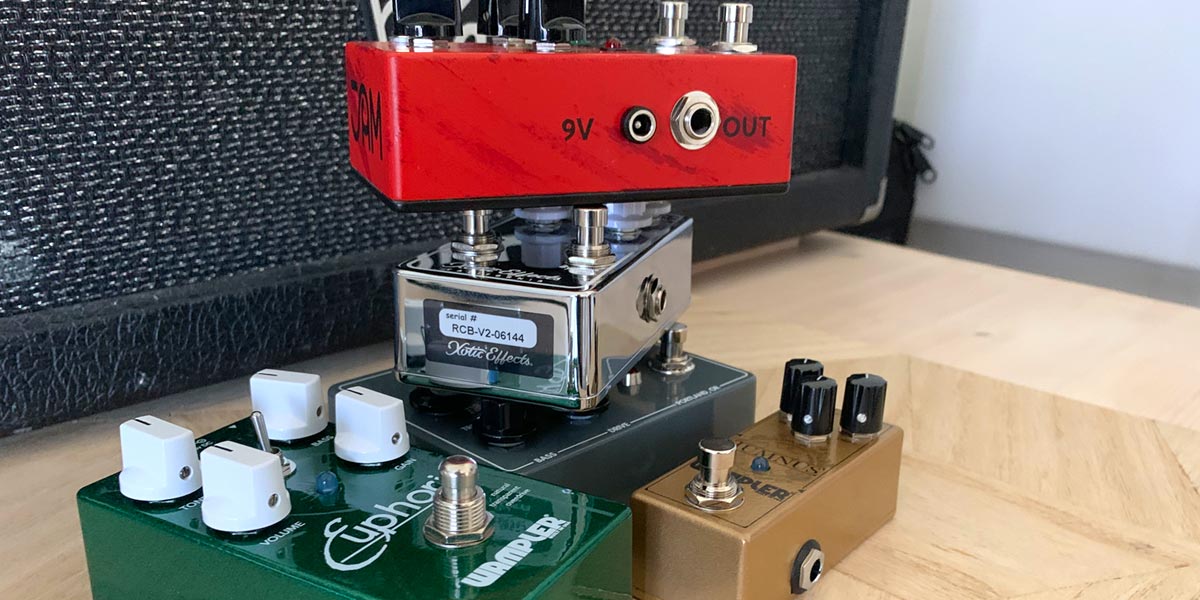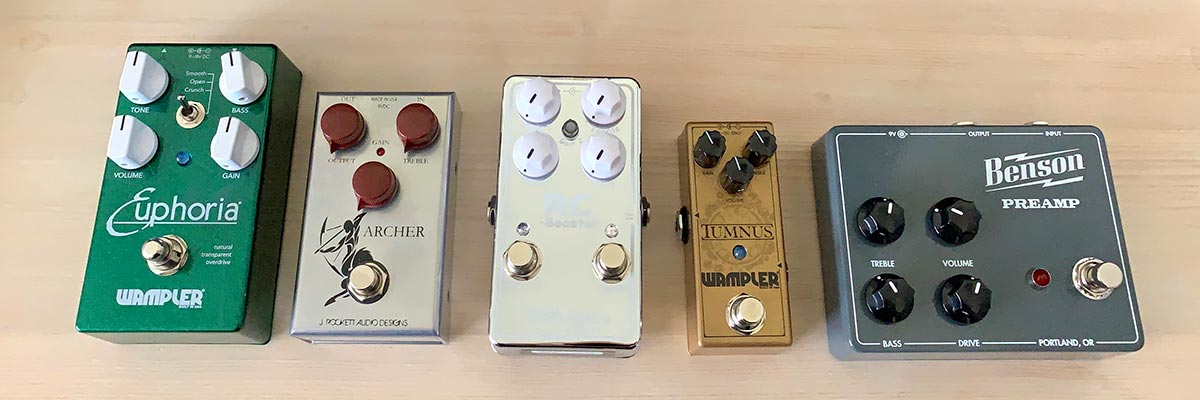
Gain stacking – or the stacking of gain pedals – is a method many guitarists use to create their ultimate and unique guitar sound.
Many guitar effects affect the gain of your signal, with gain being the amount of amplification of your guitar signal within a system. Gain is not the same as volume, volume is the final output level of the signal. When you connect multiple guitar effects – which affect the gain of your signal – in succession, you are doing gain stacking. You stack different gain levels with the aim of creating a controlled distorted sound.
Which pedals are suitable for stacking?
Next to overdrive and distortion pedals you can also use preamps for this , boosts, or other effects that affect the gain of your signal. Last but not least, your amplifier is itself an ‘effect’ that influences the gain of your signal. In order for these stacked effects to sound good, you’ll need to use them slightly differently than when you’re using them individually.
What’s the point of gain stacking?
But before we discuss how it exactly works, it is wise to first answer the question of what is the use of gain stacking in the first place. Gain stacking has a number of advantages. First of all, you can often get a very musical overdrive at lower volumes. When you set the gain on several ‘stacked’ pedals low, a very nice ‘edge-of-breakup’ sound is created.
Furthermore, you can get much higher distortion levels from your pedals through clever combinations of pedals. Metal guitarists sometimes want to connect Tubescreamer to an already heavily overdriven amplifier, which gives them even more distortion. Third, small changes in pedal combination or sequence can make big differences. This is useful if you play both Hendrix’s and Led Zeppelin’s music, for example.

Gain stacking often works best with a clean amp
When you have set your (tube) amplifier in such a way that it almost starts to overload, this means that there is little headroom. Any small increase in volume can no longer be processed by the amplifier and causes extra distortion and more compression. If you turn on some gain pedals in this situation, this will cause the overload to go to maximum and create a muddy sound with a lot of compression. It is therefore advisable to set your amplifier fairly clean so that there is enough room for the pedals.
Order of gain pedals
The easiest way is to start with a (clean) boost and an overdrive. Place the boost before the overdrive and the volume of the boost will amplify the degree of overdrive of the overdrive. If you place the boost behind the overdrive, the boost will only increase the total volume. I assume that you are using a clean amplifier with sufficient headroom. There are no hard and fast rules when it comes to the order of pedals in gain stacking, it’s just a matter of experimenting and using your ears. An almost infinite combination of pedals is possible. In general, the pedal connected last in the chain will have the most effect on your final signal. The pedal (or pedals) you connect to it changes the sound of this pedal.
EQ after your gain pedals
The most difficult thing about gain stacking is not so much the volume of the signal but the EQ. For example, if you use two pedals that are similar in timbre, there is a good chance that you will get a huge boost in that frequency range and that does not sound pleasant. It is therefore important to combine complementary pedals or to use one or more transparent or clean boosts. Furthermore, adding an EQ pedal last in the chain can also help further colorize the sound to your liking.

Examples of gain stacking
To help you on your way, I’ll give you a few examples of gain stacking below. As mentioned, there are many more options. It is mainly a matter of experimenting yourself and listening carefully to the end result.
Tubescreamer in a Big Muff
A Tubescreamer has a nice midrange bump of its own. An Electro Harmonix Big Muff has a lot of highs and lows and much less mid range. By connecting a Tubescreamer to a Big Muff you get a more balanced fuzz sound. Turn the gain of the Tubescreamer down and the volume up and listen carefully where the sweet spot is. The Muff is noticeably influenced by the Tube Screamer’s EQ profile and gets a little more punch.
Boost pedal in a boost pedal
A boost pedal provides more volume in your signal. When you combine two boost pedals and turn up the volume on the first boost pedal in the chain, you will hear the second boost pedal start to overdrive slowly. The resulting overdrive resembles the overdrive of a tube amplifier, especially if you opt for a boost with a transistor circuit. You get a little bit of compression and an overdrive that responds particularly well to volume differences in your playing. Play the strings hard and you get the full distortion, play softly and you have an almost clean sound.
Echoplex EP-3 in a distortion pedal
The Maestro Echoplex EP-3 is an infamous preamp tape echo that has been used by many guitarists over the years. A real EP-3 is now sold for thousands of euros, but fortunately there are several affordable guitar effects based on the EP-3. For example, take a look at a Catalinbread Belle Epoch Deluxe or a Dunlop EP101. In particular, it is the combination of tape echo and preamp that ensures that the distortion (which you connect behind the Echoplex) becomes completely saturated. Eddie van Halen was an avid user of this combination of effects.
Klon (clone) in a Dumble (clone)
As a final example I will discuss the combination of a klon pedal and a Dumble amplifier. Both are unfortunately unaffordable to mere mortals, but luckily there are affordable options. Use a Wampler Tumnus or a J Rockett Archer as klon pedal and for example a Wampler Euphoria or a Vertex Steel String as a Dumble pedal. The low mids and warmth of the clone clone complement the natural overdrive of the Dumble overdrive.
More about gain stacking
If you want to know more about stacking gain pedals, check out two videos below by Brian Wampler and Rhet Shull. Happy stacking!
